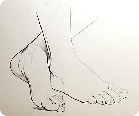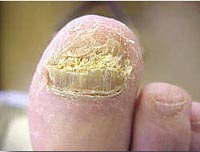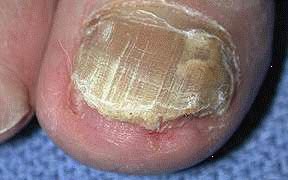



Fungus Nail (Onychomycosis)
(Onychomycosis)
WHAT'S THE PROBLEM?
Fungus Nails is an unsightly infection of the nails, causing thickened, brittle,
yellow, discolored and sometimes painful nails. It is very difficult to cure. It
is caused by one of several microscopic organisms, similar to those that cause Athlete's
Foot (dermatophytosis) These are plant like organisms that thrive in a dark, warm,
moist environment, such as within shoes and stockings. They grow in the nail bed,
beneath your nails, and live off Keratin, the protein in the nail. The condition
usually begins toward the far end of the nail and may cause white or yellow-
HOW DOES IT FEEL?
It may not be painful in the beginning, and may only look slightly different than
the normal nails. Later, the nail may begin to show small patches of white or yellowish-
LET'S DO A TEST!
Correct evaluation and diagnosis is important, as other common medical conditions, such as psoriasis, can look like Fungus Nails. Your doctor may make this decision by examination alone. He may also examine scrapings from the nail under the microscope or send these scrapings to the lab for accurate identification, to determine if the condition is a fungus and what type of fungus is responsible.
HOW DID THIS HAPPEN?
Many types of fungus are common in our environment. Among them are the dermatophytes,
a group of opportunistic parasitic plant organisms, similar to molds or mildew, that,
lacking chlorophyll, do not require sunlight for growth. Sweaty tennis shoes and
moist socks create the perfect conditions for them. The funguses thrive in a warm,
moist, dark environment and they eat the protein keratin that our skin produces.
Although funguses may be present in the skin around the nails, one may not develop
a nail infection without history of injury, such as bruised nails from short shoes,
inflammation from an ingrown nail, or from cutting the nails incorrectly or too short.
In other words, the organisms do not invade intact, healthy, normal skin or nails.
Other contributing factors would be excessive perspiration, and Dermatophytosis (Athlete's
Foot), which is caused by similar fungi. Some individuals appear to be more susceptible
to infection. These would include those with medical conditions such as diabetes
and poor circulation and HIV. For that reason, even if treatment is successful in
eliminating the condition, the susceptible person may become re-
WHAT CAN I DO FOR IT?
Topical medications are ineffective in most cases, because the infection starts growing
under the nail. No topical medicines penetrate deep enough into and th rough the nail,
to treat the living organisms under the nail plate. Any clearing of the nail surface
is eventually overtaken by infected nail replacing it from underneath. Unfortunately,
in this condition, any self treatment is, at best, temporary. Use of a topical antifungal
medicine may, at best, prevent spread of the fungus to, as yet, unaffected nails
or the surrounding skin.
rough the nail,
to treat the living organisms under the nail plate. Any clearing of the nail surface
is eventually overtaken by infected nail replacing it from underneath. Unfortunately,
in this condition, any self treatment is, at best, temporary. Use of a topical antifungal
medicine may, at best, prevent spread of the fungus to, as yet, unaffected nails
or the surrounding skin.
CAN I PREVENT IT FROM HAPPENING AGAIN?
You may be asked to treat the insides of your shoes, which have become contaminated by the fungus. This is to make sure that the new healthy nail doesn't become contaminated by any fungus hiding in the shoe. To prevent the fungus infection from coming back, the best offense is a good defense. We must control moisture and create a drier environment for your feet. Use powder in shoes, to absorb perspiration. Avoid synthetic or nylon socks that trap, rather than absorb perspiration. Cotton socks absorb moisture and wick it away from the skin and nails. Keeping your feet dry and protected from injury is essential to avoid any fungus infections. If you have been cutting your nails too deeply, or treating an ingrown nail on your own, this may have allowed the fungus to grow under the nail. If shoes have become contaminated while you had the condition, they may be sanitized by spraying them with a topical antifungal spray, to prevent a recurrence of the Fungal Nail condition.